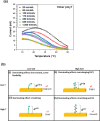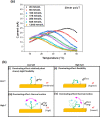Conformational Changes of Immobilized Polythymine due to External Stressors Studied with Temperature-Controlled Electrochemical Microdevices
- PMID: 33595321
- PMCID: PMC9278808
- DOI: 10.1021/acs.langmuir.0c03219
Conformational Changes of Immobilized Polythymine due to External Stressors Studied with Temperature-Controlled Electrochemical Microdevices
Abstract
Conformational changes of single-stranded DNA (ssDNA) play an important role in a DNA strand's ability to bind to target ligands. A variety of factors can influence conformation, including temperature, ionic strength, pH, buffer cation valency, strand length, and sequence. To better understand the effects of these factors on immobilized DNA structures, we employ temperature-controlled electrochemical microsensors to study the effects of salt concentration and temperature variation on the conformation and motion of polythymine (polyT) strands of varying lengths (10, 20, 50 nucleotides). PolyT strands were tethered to a gold working electrode at the proximal end through a thiol linker via covalent bonding between the Au electrode and sulfur link, which can tend to decompose between a temperature range of 60 and 90 °C. The strands were also modified with an electrochemically active methylene blue (MB) moiety at the distal end. Electron transfer (eT) was measured by square wave voltammetry (SWV) and used to infer information pertaining to the average distance between the MB and the working electrode. We observe changes in DNA flexibility due to varying ionic strength, while the effects of increased DNA thermal motion are tracked for elevated temperatures. This work elucidates the behavior of ssDNA in the presence of a phosphate-buffered saline at NaCl concentrations ranging from 20 to 1000 mmol/L through a temperature range of 10-50 °C in 1° increments, well below the decomposition temperature range. The results lay the groundwork for studies on more complex DNA strands in conjunction with different chemical and physical conditions.
Conflict of interest statement
The authors declare no competing financial interest.
Figures








Similar articles
-
DNA-based biosensors for Hg(2+) determination by polythymine-methylene blue modified electrodes.Biosens Bioelectron. 2015 May 15;67:524-31. doi: 10.1016/j.bios.2014.09.031. Epub 2014 Sep 17. Biosens Bioelectron. 2015. PMID: 25263314
-
Effect of nanoporous gold thin film morphology on electrochemical DNA sensing.Anal Chem. 2015 Aug 18;87(16):8149-56. doi: 10.1021/acs.analchem.5b00846. Epub 2015 Apr 30. Anal Chem. 2015. PMID: 25892217
-
Redox-Active Monolayers Self-Assembled on Gold Electrodes-Effect of Their Structures on Electrochemical Parameters and DNA Sensing Ability.Molecules. 2020 Jan 30;25(3):607. doi: 10.3390/molecules25030607. Molecules. 2020. PMID: 32019203 Free PMC article.
-
DNA interactions with a Methylene Blue redox indicator depend on the DNA length and are sequence specific.Analyst. 2010 Jun;135(6):1443-8. doi: 10.1039/c0an00049c. Epub 2010 Apr 6. Analyst. 2010. PMID: 20369213
-
Electrochemical properties of DNA-intercalating doxorubicin and methylene blue on n-hexadecyl mercaptan-doped 5'-thiol-labeled DNA-modified gold electrodes.Biosens Bioelectron. 2003 Jul;18(7):873-9. doi: 10.1016/s0956-5663(02)00161-6. Biosens Bioelectron. 2003. PMID: 12713910
Cited by
-
Aptamer and Oligonucleotide-Based Biosensors for Health Applications.Biosensors (Basel). 2025 Apr 29;15(5):277. doi: 10.3390/bios15050277. Biosensors (Basel). 2025. PMID: 40422016 Free PMC article. Review.
References
-
- Liepold P.; Kratzmüller T.; Persike N.; Bandilla M.; Hinz M.; Wieder H.; Hillebrandt H.; Ferrer E.; Hartwich G. Electrically detected displacement assay (EDDA): a practical approach to nucleic acid testing in clinical or medical diagnosis. Anal. Bioanal. Chem. 2008, 391, 1759–1772. 10.1007/s00216-008-2045-5. - DOI - PubMed
Publication types
LinkOut - more resources
Full Text Sources
Other Literature Sources
Miscellaneous

